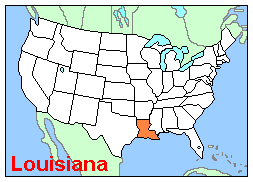America's Volcanic Past -
Louisiana
| "Though few people in the United States may actually experience an erupting volcano, the evidence for earlier volcanism is preserved in many rocks of North America. Features seen in volcanic rocks only hours old are also present in ancient volcanic rocks, both at the surface and buried beneath younger deposits." -- Excerpt from: Brantley, 1994 |

View the Geologic Time Scale

Volcanic Highlights and Features:
[This list is just a sample of
various Louisiana volcanic features or events and is by no means inclusive.]
- Louisiana
- Louisiana Regions
- Louisiana's Volcanic Rocks in South America
The surface of Louisiana is underlain by geologically young
sedimentary sequences that were deposited in
or adjacent to rivers and deltas in a coastal plain setting. These deposits and those in other states
flanking the Mississippi valley indicate that a major river system corresponding to the Mississippi has
persisted at least since the Gulf of Mexico began to form by the separation of North America from South
America. In general, the entire suite of fluvial, deltaic, and coastal deposits has advanced farther into the
Gulf through time, and continues now to fill it with sediment. Evaporation of the shallow sea that was the
early Gulf of Mexico produced thick salt deposits, now deeply buried, from which salt domes intrude the
overlying strata.
Most surface exposures in Louisiana consist of Quaternary sediment.
Louisiana's Oldest Rocks
|
||
The Atlantic Plain:3
|
||
| Louisiana's Volcanic Rocks in South America |
Louisiana's Volcanic Rocks in South America:2
Exposed in the Andes of Argentina are ancient rocks that,
hundreds of millions of years ago, once underlayed a part of
Louisiana. These rocks consist of a block of granitic continental
crust over 120 miles (200 kilometers) wide, capped by 3,000 to 4,900
feet (900-1500 meters) of 470 to 570 million year-old sedimentary
strata. These strata are composed of fossiliferous limestone
and dolomite overlying shale and sandstone.
This block of continental crust called the "Precordillera
Terrane," once was part of North America. However, opening
of the Iapetus Ocean, a predecessor to the Atlantic Ocean, rifted
the Precordillera Terrane away from North America, leaving
oceanic crust where Louisiana now lies. Then, plate
tectonics caused the block to drift across the ancient Iapetus
Ocean. Eventually, this feature collided with and was welded
onto a continental land mass that became South America.
Excerpts from:
1) Louisiana Geological Survey Website, July 2001
2) Louisiana Geological Survey Website, Louisiana GeoFacts, July 2001
3) USGS/NPS Geology in the Parks Website, September 2001
[Return to
America's Volcanic Past - States and Regions]
[Return to
America's Volcanic Past - National Parks and Monuments]
[Return to
Visit A Volcano Menu]

